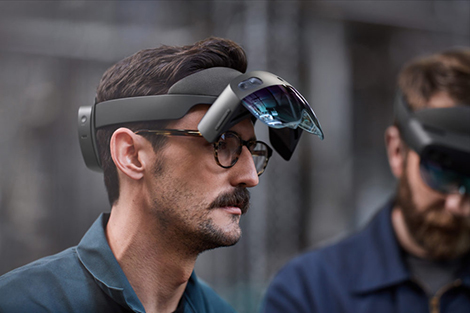
HoloLens 2 is glasses-friendly, and you can flip up the visor so you can switch tasks easily
This week at the Mobile World Congress in Barcelona Microsoft introduced HoloLens 2, its much anticipated next generation wearable holographic computer.
Microsoft was joined by PTC who showed how it has combined its IoT edge solutions, the Microsoft Azure cloud and mixed reality tools to digitally transform businesses of all kinds, from aerospace and defence to clothing brands and life science companies.
HoloLens 2 features more than double the field of view than the original mixed reality device, which many found to be a significant limitation. There’s also a new visual display system, which Microsoft says makes the holograms even more vibrant and realistic.

Howden Global leader for Data-Driven Advantage Maria Wilson and PTC president and CEO Jim Heppelmann appear onstage at MWC Barcelona
The updated device includes new eye-tracking sensors that are designed to make interacting with holograms even more natural.
For example, when someone’s eyes land on a particular part of a machine, it can call up useful digital information about it.
Interaction with holograms has also been made easier. With natural hand tracking, users can now grab and rotate them as they would a real-world object, rather than having to learn gestures that mimic mouse movements.
“For the first time, you’re going to feel what it feels like to touch a hologram, to interact with a hologram and to play with it, almost where you forget that this is a piece of digital content you’re looking at as opposed to it just existing in the real world,” said Alex Kipman, technical fellow in Microsoft’s Cloud and AI group.
HoloLens 2 also includes iris recognition with Windows Hello authentication to make it easier for multiple users to log in and share the device. A new flip-up visor lets users switch easily between physical and holographic worlds.
Comfort has also been addressed. Microsoft says the new dial-in fit system makes the HoloLens 2 comfortable to wear for ‘hours on end’. Users can also wear glasses with the mixed reality headset because it now adapts by sliding right over them.
PTC, one of Microsoft’s partners for the launch, has developed integrated systems that combining its ThinWorx IoT solutions for the Azure cloud to allow a user to put on a HoloLens 2 device and see a holographic dashboard with each component’s health and status mapped in MR onto a physical real world machine.
“Several years ago, a blinking light or vague error message might be the only clue to what’s wrong,” said Jim Heppelmann, president and CEO of PTC. “[They’d] probably call the manufacturer, who might or might not be able diagnose the problem over the phone. Mostly likely, they’d have to dispatch a repair person for that specialised machine who might or might not work in that city.
“It could take hours or days of downtime to get it back up and running.”
Using the HoloLens 2, a user could now access step-by-step holographic instructions showing how to open a cover, which lever to flip, how to insert the new part. If this still poses a problem a repair expert sitting in the manufacturer’s office in on the other side of the world could look at a screen, see exactly what she sees through HoloLens 2 and walk the wearer through the job.
“It’s a closed loop between humans and things,” Heppelmann said. “The IoT devices tell me what’s wrong, and the mixed reality solutions allow me to repurpose that blood test technician into someone who’s able to fix a simple problem that saves time and money on airplane tickets and rental cars.”

Epic Games also announced that Unreal Engine 4 support is coming to HoloLens.
Finally, Microsoft has introduced new Azure mixed reality services that are designed to help developers build mixed reality applications. One of these is Azure Remote Rendering, which helps reduce the need to “decimate,” or simplify a 3D model so it can run on target hardware.
This service will render high-quality 3D content in the cloud and stream it to edge devices, all in real time, which will help retain a higher level of detail for scenarios like design review. Azure Remote Rendering is currently in private preview. Meanwhile, Azure Spatial Anchors allows people to create holograms that persist in a specific physical space.
Microsoft has also released mixed reality applications for Microsoft Dynamics 365 to help companies use HoloLens 2 without needing to hire developers. Dynamics 365 Guides, for example, helps companies move training materials from flat paper and screens into an immersive three-dimensional experience.
It joins Dynamics 365 Remote Assist and Dynamics 365 Layout which were announced last year.
HoloLens 2 will be available this year at a price of $3,500.






